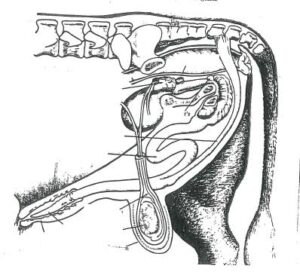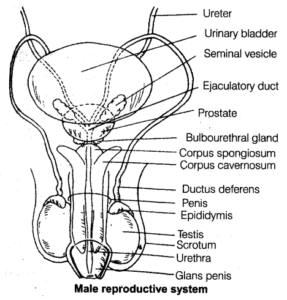Back to: ZOOLOGY 300 Level
Welcome To Class!
Hello, my brilliant friend! I’m so excited you’ve joined us today to explore two of the most essential systems in your body — the nervous system and the reproductive system. These systems are what make life interesting and allow us to interact with the world and reproduce. Ready to learn? Let’s go!
Nervous And Reproductive Systems
The Nervous System: The Body’s Communication Network
The nervous system is the body’s communication network, responsible for processing information and sending signals between the brain, spinal cord, and all parts of the body. It allows us to react to stimuli (like touching a hot stove) and helps us control our thoughts, emotions, and movements.

- Main Components:
- Brain: The brain is the control centre of the nervous system. It processes sensory information, makes decisions, and sends signals to the rest of the body.
- Spinal Cord: The spinal cord connects the brain to the rest of the body. It acts as a highway for messages to travel from the brain to the body and vice versa.
- Nerves: Nerves are like electrical cables that carry messages between the brain, spinal cord, and other parts of the body. They allow us to feel sensations, move muscles, and respond to our environment.
- How It Works: When you touch something hot, sensory nerves in your skin send a message to the brain, which processes it and tells your muscles to pull away quickly. This happens in a split second, showing just how fast and efficient your nervous system is.
- Types of Nervous System:
- Central Nervous System (CNS): Made up of the brain and spinal cord, the CNS processes information and directs responses.
- Peripheral Nervous System (PNS): Made up of nerves outside the brain and spinal cord, the PNS connects the CNS to limbs and organs. It includes sensory nerves and motor nerves that control movements.
The Reproductive System: The Continuation of Life
The reproductive system is responsible for creating new life. It includes the organs and structures that produce offspring. While this system may be different in males and females, the overall goal is the same — to produce offspring and ensure the survival of the species.

- Male Reproductive System:
- The testes produce sperm and the male hormone testosterone.
- The penis and urethra are used for delivering sperm during sexual intercourse.
- The seminal vesicles and prostate gland add fluids to the sperm, forming semen, which carries the sperm to the female reproductive system.
- Female Reproductive System:
- The ovaries produce eggs (ova) and the female hormone estrogen.
- The fallopian tubes transport the eggs to the uterus. If sperm meets an egg, fertilisation can occur here.
- The uterus is where the baby develops during pregnancy. It has a thick, muscular lining to support the growing fetus.
- The vagina is the canal through which the baby is delivered during childbirth.
- How It Works: During sexual intercourse, sperm is released and travels through the female reproductive system to meet the egg for fertilisation. If fertilisation occurs, the fertilised egg attaches to the uterine wall and develops into a baby.
- Menstruation: If the egg is not fertilised, the female body sheds the lining of the uterus through a process called menstruation, which usually occurs once a month.
How the Nervous and Reproductive Systems Work Together
The nervous and reproductive systems interact in many ways. For example:
- During sexual arousal, the nervous system sends signals that result in physical changes in the reproductive organs, allowing for sexual intercourse to occur.
- The brain also controls the release of hormones that regulate the reproductive process. This includes the release of eggs in females and the production of sperm in males.
In pregnancy, the nervous system plays a role in detecting the pregnancy and helping regulate changes in the body to support the developing baby.
Summary
- The nervous system is the body’s communication network, including the brain, spinal cord, and nerves. It processes information and sends signals that control body movements and reactions.
- The reproductive system is responsible for producing offspring, with organs like the testes and ovaries producing sperm and eggs, respectively. In males, sperm is delivered via the penis, while in females, the egg is fertilised in the fallopian tubes and develops in the uterus.
- The nervous and reproductive systems work together to control sexual arousal, hormone release, and even the physical changes that occur during pregnancy.
Evaluation
- What are the main components of the nervous system, and what is their role?
- Explain how the male and female reproductive systems work together to create offspring.
- What is the function of the brain in the nervous system?
- How does the nervous system influence the reproductive process, especially during sexual intercourse?
- What happens during menstruation, and why is it important for the female reproductive system?
Great job, my friend! You’ve just learned about two of the most important systems in your body: the nervous system and the reproductive system. These systems help you react to your environment and keep life going. Keep up the fantastic work, and don’t forget — Afrilearn is always here to support you on your learning journey. See you in the next lesson!
